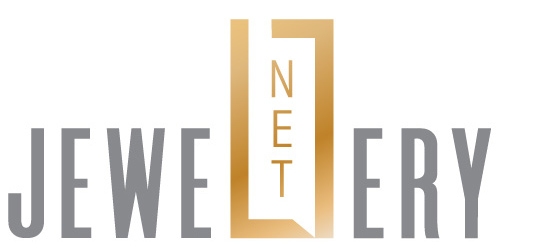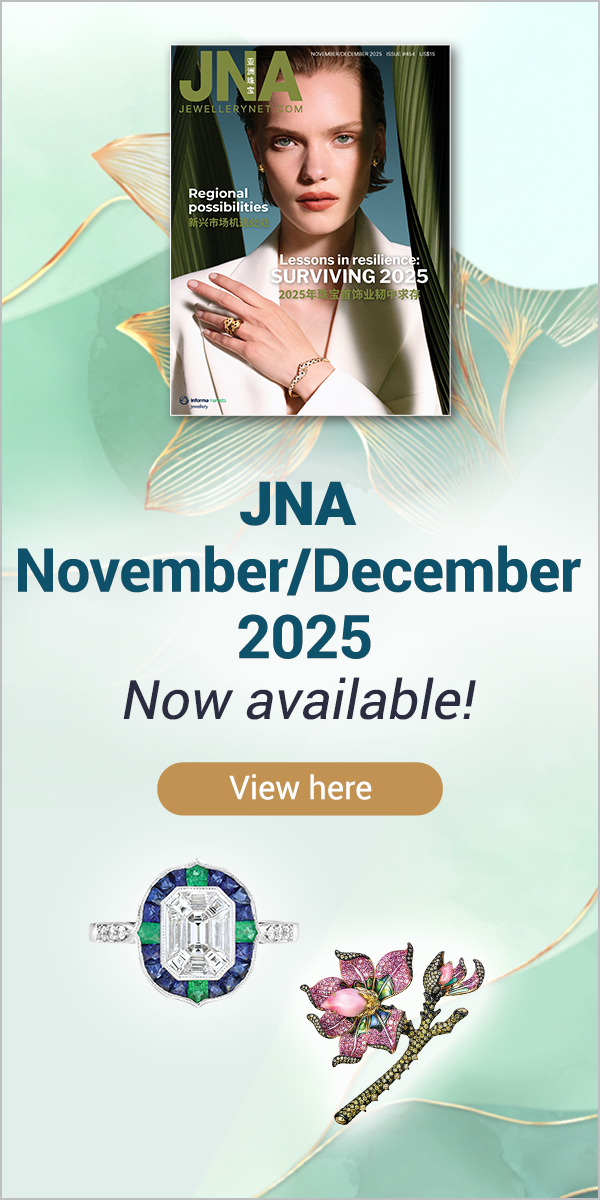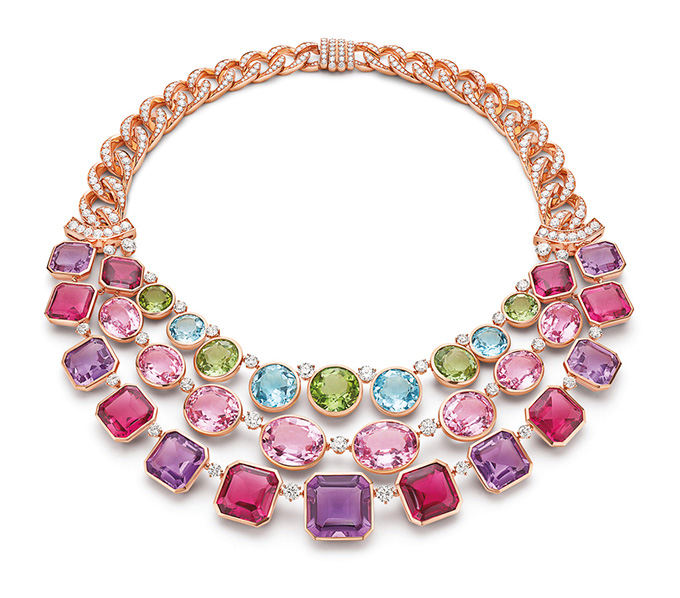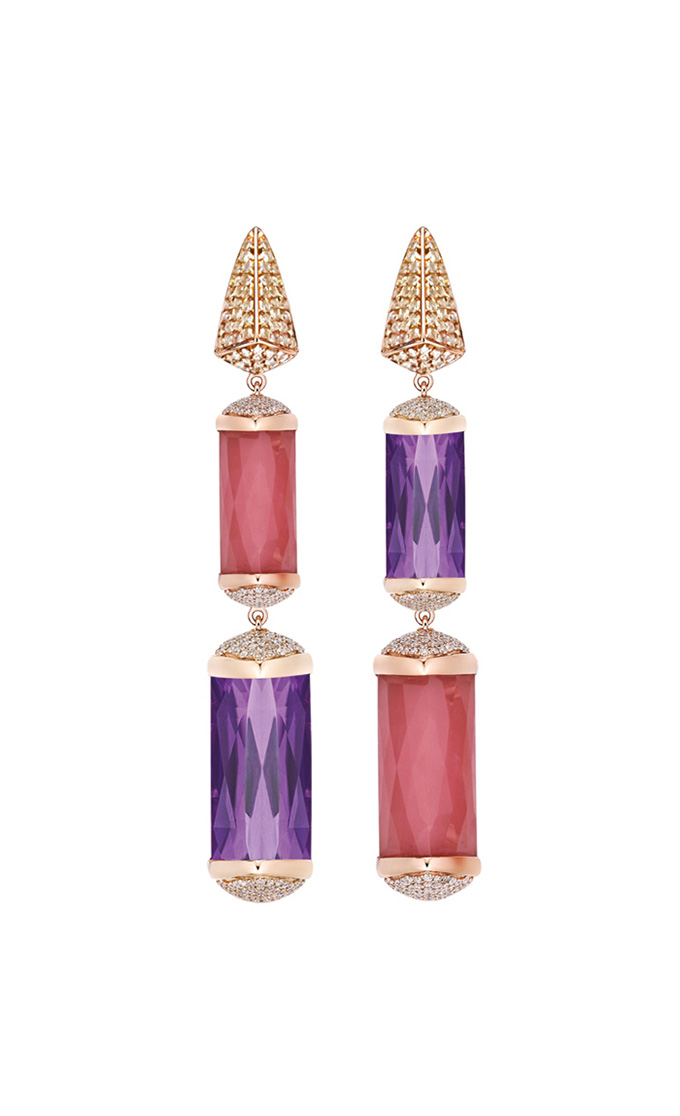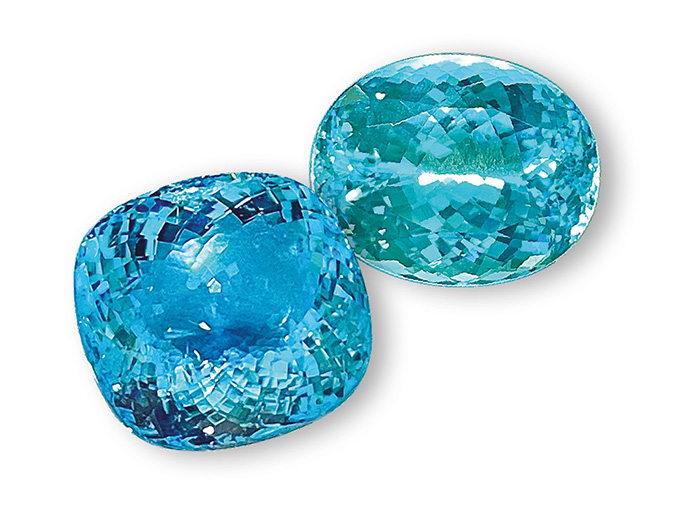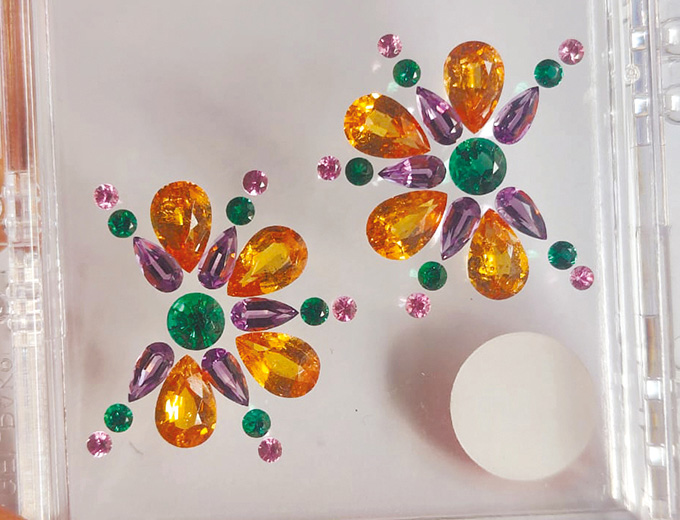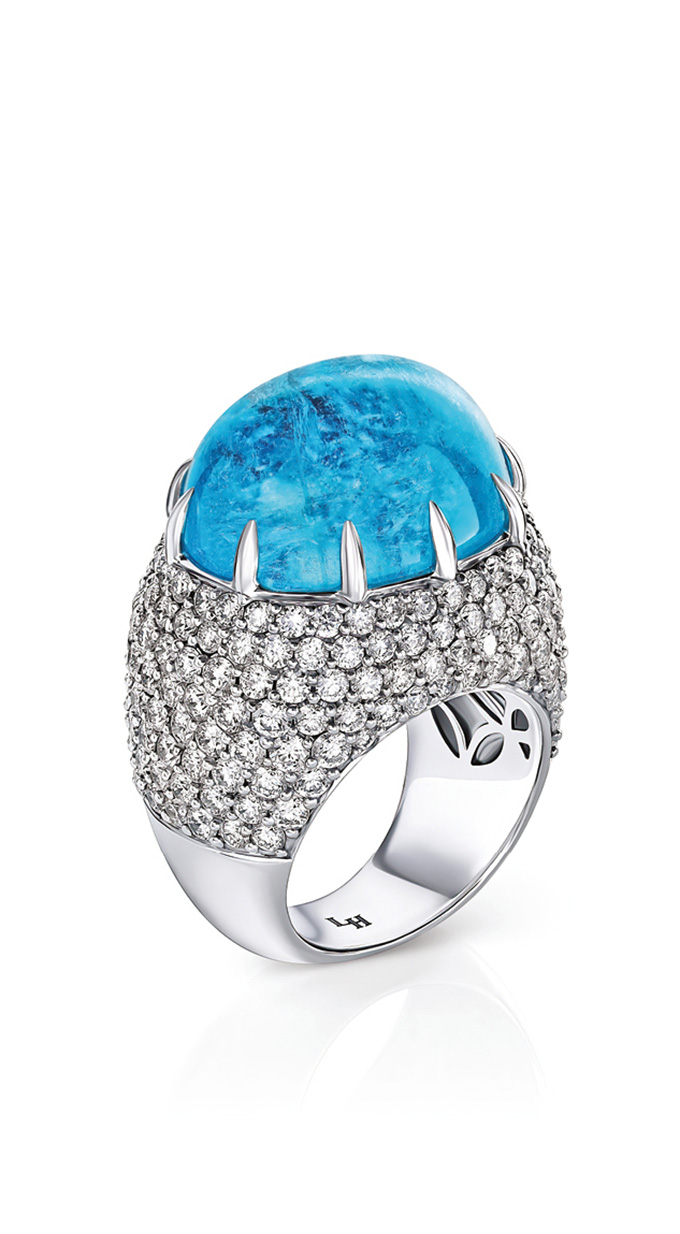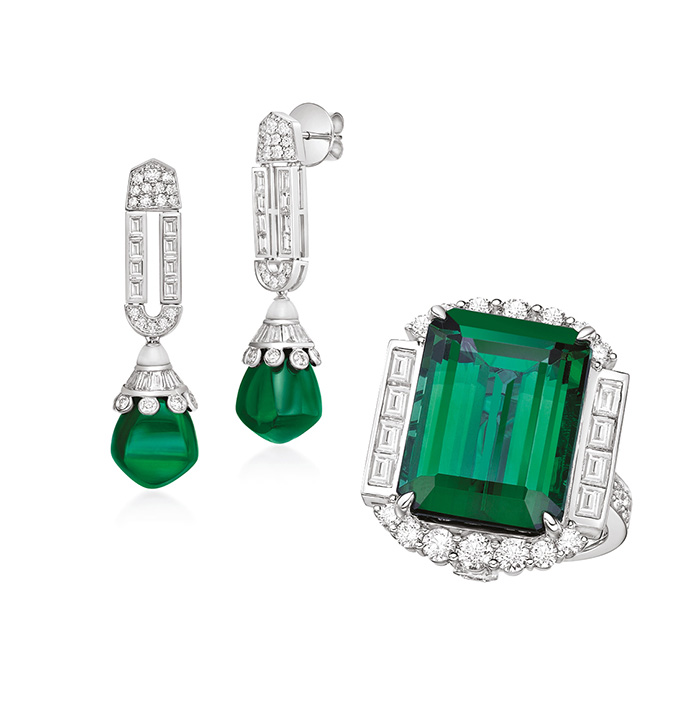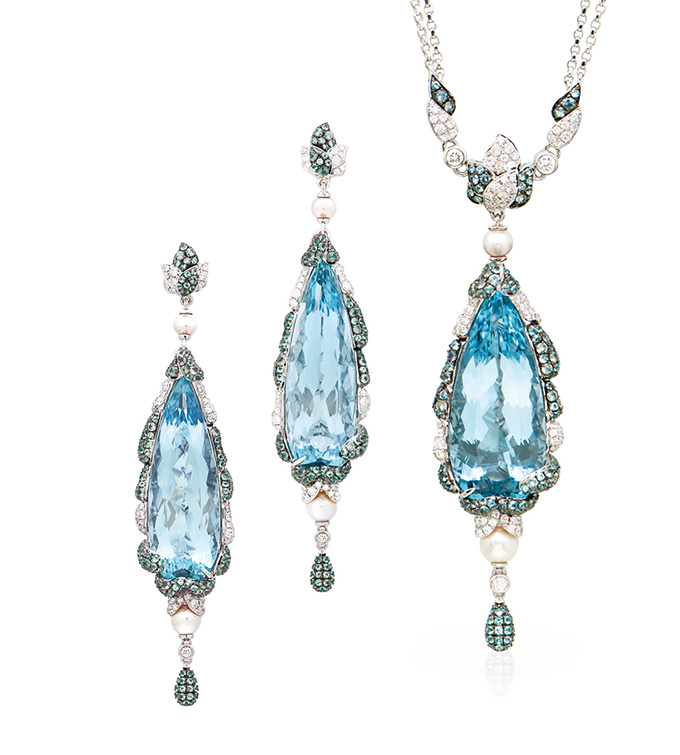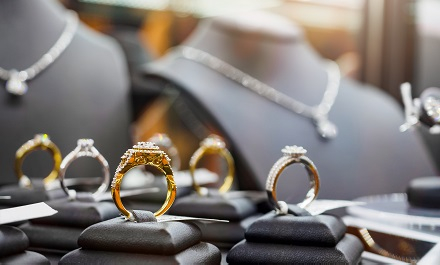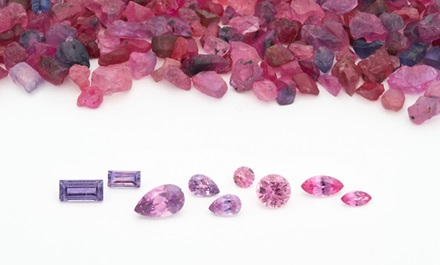More coloured gemstones are coming into their own as the fine and luxury jewellery markets explore diverse prospects in stones and cuts, amid soaring prices and supply constraints.
This article first appeared in the JNA May/June 2025 issue.
A novel crop of coloured gemstones is gaining prominence in the market as luxury brands, jewellers and designers seek fresh options to inject colour, character and ingenuity in their offerings.
While rubies, emeralds and sapphires still dominate luxury jewellery collections, they increasingly share the spotlight with other gems that arguably enable greater creativity and higher margins.
Gemstone manufacturers and dealers affirm heightened interest in a wider variety of coloured gems in recent years.
Thanamwat Saenfoo, general manager of Thailand-based Fancy Spinel Gems Co Ltd, said, “As markets mature, their knowledge and appreciation of coloured gemstones deepen. They realise that certain stones are even rarer than gem-quality diamonds or the Big Three – rubies, emeralds and sapphires. This rarity heightens their value as luxury gems and makes them even more appealing to jewellers and designers that aim to offer unparalleled propositions to their customers.”
Softer demand for natural diamond jewellery is another catalyst, noted Keen Jade Ltd Director Rbhava Kumar Nahata. The Hong Kong-based jewellery manufacturer, which has production facilities in Thailand and India, specialises in coloured gemstone jewellery for retailers, brands and chain stores in the US, the Middle East and Europe. It also produces premium gemstone jewellery for its own brand, Sunita Nahata Fine Designs.
Rbhava said, while diamond jewellery still has its rightful place in the trade, buyers believe there is no harm in adding colour to their assortment.
“As the market is saturated with diamond jewellery, retailers are looking to include coloured gemstones to their showcases because these provide a different appeal and variety to their offerings. These will always bring customers in since gemstones allow you to experiment with designs, cuts and colours,” he disclosed.
And as coloured gemstones gain ground, gem-set jewellery pieces featuring new favourites, ingenious colour combinations and innovative cuts are proving a compelling alternative for consumers.
A new trio
Paraiba tourmaline, spinel and aquamarine are the current frontrunners in luxury jewellery creations, with their alluring hues and versatility winning over buyers.
Shantanu Navlakha, owner of Hong Kong-based Astrella Creations, said Paraiba tourmaline pieces are his brand’s best sellers. Sales have been especially strong in China and in some pockets of the Middle East. Potential for growth is tremendous, given that the Middle East has just recently started to embrace the stone, he revealed.
Spinel is having a moment too, thanks to its varied colours and exceptional lustre.
Jewellery designer Alexander Laut confesses to a fascination with the gem. “Spinel stones are beautiful, and they are highly collectible in an expansive palette of colours. Aside from red and pink, there are beautiful grey, blue and orange stones, among others,” he said.
Saenfoo of Fancy Spinel Gems noted that despite continually rising prices, demand for spinel remains robust. Clients are willing to pay a premium as the stones are not as expensive as rubies and come in a wide range of pink and red shades. He added, “Our selection of cobalt blue spinel from Tanzania is equally engaging, with some buyers mistaking the stones for sapphires.”
Aquamarine, particularly in the Santa Maria colour, is another stalwart in luxury jewellery lines. Saenfoo disclosed that his company’s loupe-clean Santa Maria aquamarines have a consistent following among upmarket jewellery designers and brands.
Rbhava of Keen Jade, attested to this, noting that Santa Maria aquamarines have been steadily growing in popularity over the years. “There is a real appreciation for aquamarines of late. It was never really treated as a high-end stone before, but people are now really using aquamarines in this top colour in fine and high jewellery,” he shared.
But while more affordable than the coloured gemstone royalties, emerging gem favourites can also command higher prices, especially the good-quality material.
Saenfoo said prices for better Paraiba tourmaline from Mozambique can easily double year on year, reaching around US$20,000 per carat and upwards of US$30,000 per carat for unheated stones.
Good-quality spinel, meanwhile, can easily fetch US$15,000 to US$25,000 per carat, and prices of cobalt spinel from Mahenge, Tanzania may soon rival those of their Vietnamese counterparts, he continued.
Emerging luxury gems
Apart from the new trio, several other gemstones – many of which are more competitively priced – are likewise making their way into high jewellery lines.
Rubellite has been enjoying a starring role in luxury jewellery brands’ recent releases. Cartier’s Nature Sauvage High Jewellery Collection trains the spotlight on the red gem in several key masterpieces. Its Chryseis Necklace alludes to fluttering butterfly wings through onyx and diamond patterns and round chrysoprase beads anchored by a 63.76-carat rubellite.
The zebra-themed Koaga Necklace has a 6.25-carat pear-shaped rubellite dangling from onyx and diamond stripes. The gemstone also takes pride of place in the turtle-inspired Mochelys Brooch/Necklace that is enhanced by a 71.90-carat rubellite.
Bulgari likewise expands the focus on less conventional stones in its Aeterna High Jewellery Collection. Case in point is the Earth Song necklace that includes round, oval and squared rubellites, amethysts, green tourmalines and diamonds in three strands of pink gold.
For its part, Boghossian’s Inlay Crush Collection sets morganite, peridot and aquamarine in minimalist styles.
Jewellery houses’ support for a wide range of gems is mirrored in the trade. According to Keen Jade’s Rbhava, there is a surge in interest for high-end pieces with tourmaline, from pink and lagoon tourmaline to indicolite and rubellite. “While their prices have increased substantially over the years, tourmalines are still available in larger sizes that hold deep colours. Equivalents in the usual luxury gems would be prohibitive, not to mention challenging to find,” he explained.
Laut observes that the Middle East market is interested in rubies, emeralds and sapphires but also nurtures a growing appreciation for tourmalines.
“Rubellite is a great alternative to ruby. For starters, few can afford a 50-carat ruby. A 50-carat rubellite would enable one to have that big red statement piece,” said Laut, who specialises in big cocktail rings.
Effective alternates
Dharmendra Tank, owner of coloured gemstone specialist Heeralal Chhaganlal Tank, likewise points to increased market fascination for exotic, rare and less conventional stones. Aside from the coloured gemstone royalties and the emerging stars, rubellite, morganite, tourmaline and tanzanite have been doing particularly well for his company.
“Consumers are veering toward colour in their jewellery, and they all want something different. For this reason, more gemstone varieties are moving well. Given current prices and supply constraints, you need to look beyond the Big Three to offer more substantial designs and striking colour combinations,” Dharmendra said.
Again, these fine alternatives are not necessarily inexpensive. A nice rubellite can fetch US$2,000 to US$5,000 per carat, he revealed.
“Bigger rubies and sapphires however are not readily available. If you want stones of 5, 10 and 15 carats, you need to explore other options. For instance, some tanzanite stones may seem royal blue in the light, not violet. Rubies are not the only red stones nor are emeralds the only green ones,” Dharmendra continued. “Jewellers that need bigger stones at a smaller budget for their designs have no choice but to consider further possibilities.”
Indeed, replacement stones are increasingly proving their worth – and value – in the market. Saenfoo sees tsavorite making headway as an emerald alternate. Given its limited production, it is a rarer stone. Well-informed customers seeking green stones consider tsavorite as a good investment and a new selling point to consumers who want different choices, he said.
Forms and shapes
Special cuts and colour combinations are further points of differentiation that are serving gemstone dealers well.
Heeralal Chhaganlal Tank banks on its capabilities in these areas to stand apart from the competition. Its portfolio includes layouts combining spessartite garnet, amethyst, emerald and morganite for jewellers wishing to produce dramatic sets at reasonable prices.
Another ingenious offering is its selection of little tower cubes of gem-quality amethysts with square facets and rounded edges. The stones are offered in matching pairs and sets so clients can readily create their collections. “These cuts are extremely difficult to do and result in a lot of weight loss. But they highlight our cutting prowess and give us an edge in the business,” Dharmendra said.
Unusual cuts are highly favoured in Hong Kong, mainland China and Europe. He remarked, “Jewellery manufacturers, designers and brands from around the world increasingly seek different gemstones, colours and cuts to stand out from the rest.”
Amethyst also features in one of Keen Jade’s special designs – a pair of earrings with amethyst and guava quartz in a baguette briolette cut where the gemstone is domed at the top, flat at the bottom and has triangular facets.
Cabochons are also making the rounds of luxury jewellery collections. The Bulgari Lotus Cabochon Necklace uses rubellite, turquoise, emerald and amethyst cabochons to create a floral shape, while the brand’s Augustus Aeternus Emerald Monete Sautoir combines diamonds and 149 emerald beads weighing a total of 615.04 carats to hold up a rare bronze coin pendant.
Navlakha of Astrella Creations is just as enamoured with cabochons, which he describes as having “a nice bold look that is unparalleled.” Among his brand’s masterpieces is a long tanzanite and emerald necklace that intersperses cabochons and faceted stones.
Sugarloaf cabochons are a favourite of Laut, who believes they work well with design-led pieces.
“It is a gross misconception that cabochons are of inferior quality to faceted stones. Some stones may be ideal for cutting but others are exceptional as cabochons. It largely depends on the stone and the designer’s concept,” explained Laut.
Dharmendra of Heeralal Chhaganlal Tank concurs, noting that gem-quality cabochons are hard to source and quite pricey, though they cost less than their faceted counterparts. “Cabochons result in less recovery for us, but these decisions are made based on what is more beautiful. I have always felt that cabochons and unusual shapes have a depth of character unseen in other stones,” he shared.
German lapidarist Nebert draws the same conclusion. The company, which works primarily with goldsmiths, jewellers and designers, has an extensive assortment of cabochons in various sizes and qualities in its inventory.
According to company manager Sascha Nebert, some clients prefer the smooth cuts of cabochons in the higher grades over the sparkle of faceted gemstones. He said, “Cabochons have been selling well these last few years. Though these are generally perceived as less valuable than faceted stones, our cabochons are made of high-quality material with hardly any inclusions.”
Cabochons also add depth and dimension to jewellery pieces, making them seem bigger than with a faceted stone. Top-quality cabochons are also attractive in their rarity.
